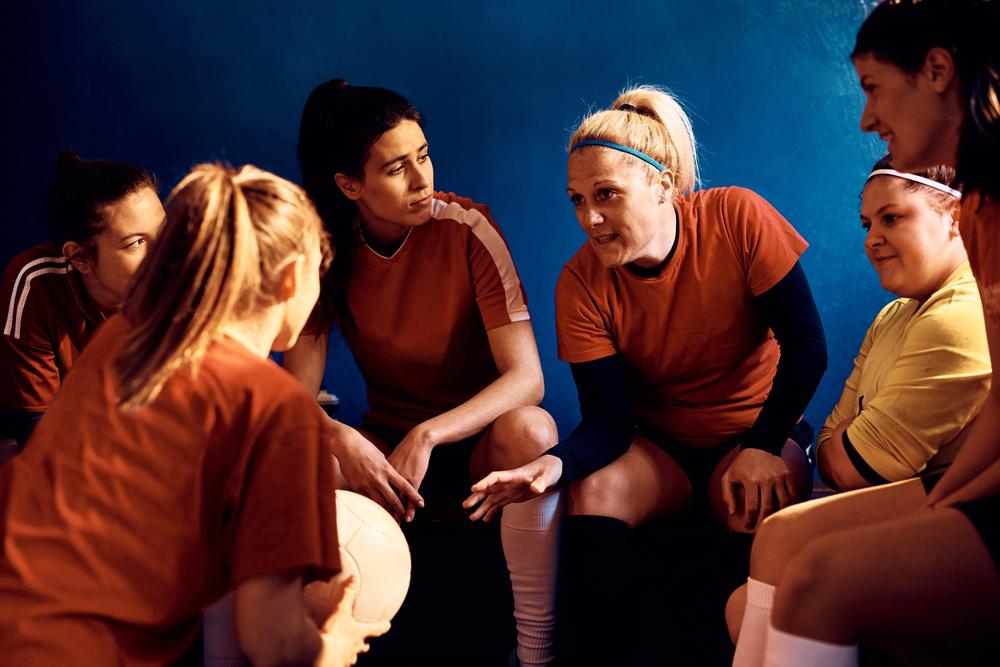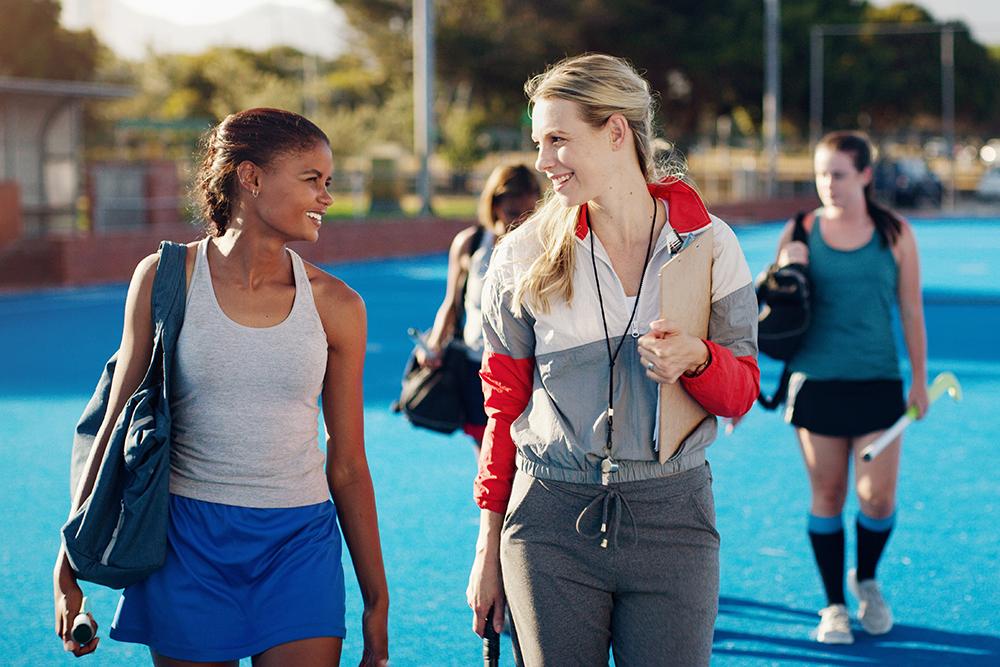 Content Warning: This article contains mentions of trauma.
Content Warning: This article contains mentions of trauma.
If you often find yourself having arguments with your athlete about things like getting to practice on time, an unfair coach or referee, or what your athlete could have done better after a bad game, there are some simple ways to improve your style when it comes to dealing with conflict. And not only will this help your relationship, but modeling good conflict resolution will also benefit your athlete in other areas of their lives.
Here, TrueSport Expert Betsy Butterick, a coach and communication specialist, explains why conflict is normal and even necessary, and how you can make arguments with your athlete less stressful and more helpful.
Conflict Is Normal and Necessary
“Conflict isn’t a bad thing,” says Butterick. “Conflict is a very normal experience and it’s everywhere. Unfortunately, we have a very negative view of what conflict and confrontation mean. We tend to view them as negatives, but if we’re going to work to be better at confrontation and to feel more comfortable in conflict, we have to learn new ways of looking at those things.”
Like most things in sport and life, the ability to deal with conflict is a skill that can be improved upon and developed. For many, conflict resolution is not an inherent skill, and it takes practice. “Most people have yet to be taught how to do conflict and confrontation,” says Butterick. “They have to be taught skills that help them feel more confident and capable and safe in those types of situations.” For most young athletes, being able to ‘practice’ the art of working through conflict with a parent allows them a safe space to experiment, learn, and develop.
People Have Different Histories of Conflict
“One challenge is that many people have had an experience with conflict or confrontation where it hasn’t been safe, or it hasn’t been positive, or it’s been traumatic in some way,” says Butterick. “And so, they are not motivated at all to revisit those types of conversations.”
While you likely believe that you have a good sense of your own athlete’s background and history with conflict, you may not know about every time your athlete has dealt with a conflict, and how it impacted them. A fight with a childhood friend that ended in months of not speaking to each other may seem trivial to you but could have been hugely impactful to them. And outside of your own athlete, it’s important to remember that you don’t know the full history and background of their coaches or teammates. Their responses to conflict may be based on past trauma. Because of this, some people go to great lengths to avoid confrontations and conflicts.
Conflict Can Bring People Together
Rather than try to shut down arguments and conflicts with your athlete in the car after practice, embrace them as a positive thing for your relationship. “Confrontation is often one of the healthiest ways to build trust in a relationship when it’s done well,” says Butterick. “People who go through conflict together and come out the other side are often better for it, not just in the moment, but long term. This is because they’re learning how to do hard things together.”
“But for these conflicts to have good outcomes, we have to practice,” she says. “This means practicing before we really need to execute these skills at a high level.” For example, an argument with your athlete about their curfew after a game is a low-impact conflict that’s great practice for when they need to have a conversation with their coach about a disagreement with the starting lineup for state championships.
Caregivers Get Triggered Too
“It’s also important to start to understand your own emotional reactivity and triggers in these confrontational moments with your athlete,” says Butterick. “We need to come to a place where we can have a better quality of conversation.”
And remember: It’s okay if you get emotional during a conflict with your teen. “You will not always be the ideal parent,” says Butterick. “That’s okay. The thing that matters most is whether you can circle back and say, ‘When I yelled before, that wasn’t what I should have done. That was a bad choice on my part, and I’m sorry for raising my voice. This is what I wish I would have said…'”
Check your Assumptions
 “Conflict rarely goes well when you come in with an assumption,” says Butterick. She recommends checking in with yourself as these conflicts begin: Make sure that you’re keeping an open mind and not assuming that you know exactly what the problem is, or what the answer is. And check in to ensure that you’re genuinely curious about your athlete’s story, feelings, and responses.
“Conflict rarely goes well when you come in with an assumption,” says Butterick. She recommends checking in with yourself as these conflicts begin: Make sure that you’re keeping an open mind and not assuming that you know exactly what the problem is, or what the answer is. And check in to ensure that you’re genuinely curious about your athlete’s story, feelings, and responses.
“You can think through your own assumptions in real time by asking questions,” says Butterick. “If your athlete is complaining that the coach yelled at him, rather than making an assumption that your athlete deserved it or conversely, that the coach should be fired, ask more questions. Your response could be as simple as, ‘Tell me more.’ Or you can ask a follow-up question. Curiosity is the best practice in this situation.”
Separate the Behavior from the Person
Especially when it comes to conflicts with your child, it’s easy to slip into ‘always’ and ‘never’ thinking, or to assign a person-based judgment to a situation rather than separating out the behavior. For example, if your athlete struggles to get ready in the morning and is often late to practice, avoid saying that your athlete is lazy or selfish. Instead, say that being late to practice is disrespectful because it’s slowing down the team.
Serious Conversation? Have a Plan.
If you need to have a serious conversation with your athlete (or vice versa), and you’re fairly certain that a confrontation or conflict will ensue from it, don’t try to have it during your 10-minute drive to practice. Instead, make time and space for the conversation.
“Think about the elements separate from the actual conversation,” says Butterick. “Where are you planning to have the conversation? Is there a space where you both can talk freely? Are there constraints on your time? Can you intentionally curate an environment that supports the kind of conversation that you want to have?”
Be Willing to Pause
During any conflict with your athlete, it’s a good idea to have a rule in place where either of you can press ‘pause’ on the argument. This could be for the length of a song, or it could be for an hour or a day. But allow yourself and your athlete the ability to ask for space when needed. The best thing that you can do for your athlete is to simply ask them what they need from you in the moment, and if the answer is space, respect that.
“Look at conflict like a basketball game,” says Butterick. “You’re allowed a certain number of timeouts. You might use them all, or you might not. But you have them if you need them.” Sometimes, an athlete simply needs 10 minutes to collect themselves before continuing a conversation. As the caregiver, you’re likely tempted to keep pushing them to talk to you, either out of frustration or a misguided effort to get to the bottom of what’s wrong. Giving your athlete a moment to get composed before continuing can allow them to have a better conversation with you, rather than feeling anxious and attacked.
_____________________________
Takeaway
Fighting with your young athlete is normal, especially in heated emotional moments, like after a tough game. Don’t avoid this conflict. Instead, help your athlete learn to communicate and express their feelings, become aware of their emotions, and learn how to move through them in a safe space. When navigating conflict with your athlete, remember to avoid assumptions, ask questions, and be willing to pause the conversation.



